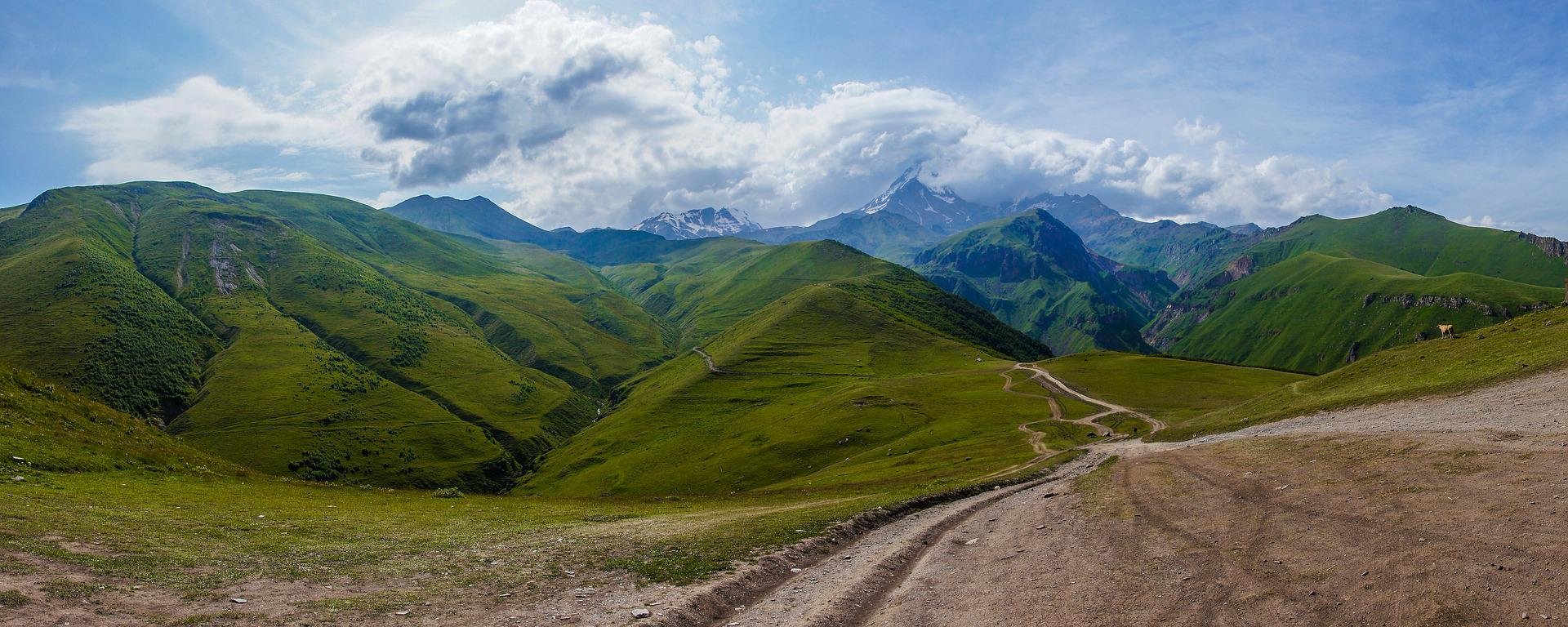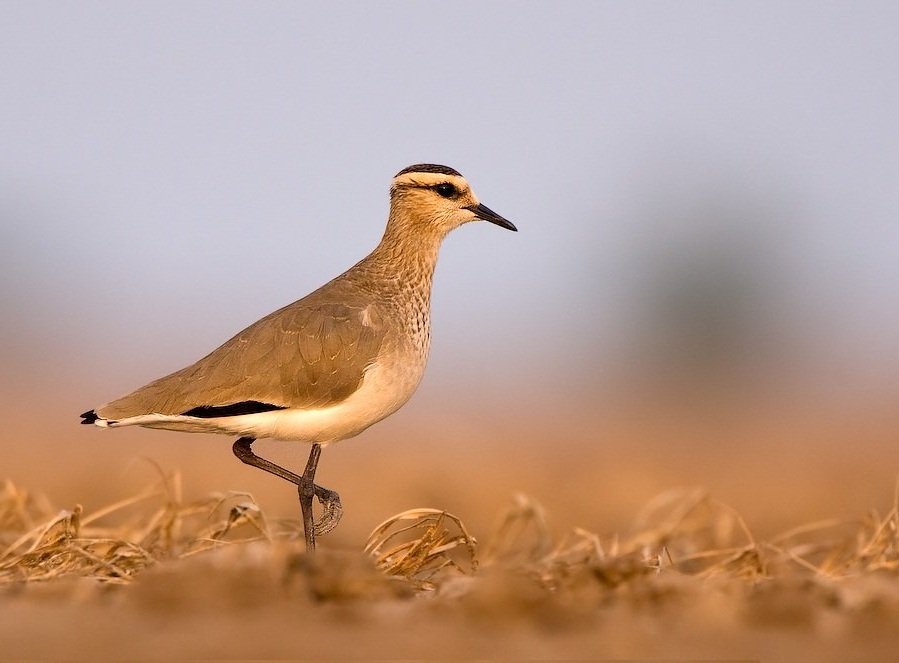
Georgia
Common Name: Sociable Lapwing
Scientific Name: Vanellus gregarius

Fact
The “sociable” part of the sociable lapwing’s name came about as a result of observations of the species gathering in large numbers along its migratory routes.
About
Image: © Huw Roberts
Overview:
The sociable lapwing is a migratory shorebird that breeds mostly in Kazakhstan but winters in countries ranging from eastern Africa through the Middle East and to South Asia. With different groups of the species wintering in different areas and taking different migratory routes, it can be found traveling through many countries including Georgia.
The sociable lapwing chooses its breeding sites based on the availability of suitable habitat which in turn depends on the location of grazers across its breeding area in Kazakhstan and southern Russia. This results in the inconsistent selection of breeding sites from year to year which has made the species something of an enigma to those wishing to conduct population surveys in the past. However, more recent fieldwork conducted using satellite trackers has revealed that the sociable lapwing is more abundant than was once feared. Despite this the species remains critically endangered due to high mortality rates along its migratory routes.
Lifespan:
The actual lifespan of the sociable lapwing is uncertain because of the high rate of human caused mortality that they face during their migration. However, the closely related Northern Lapwing has a lifespan of approximately 4-5 years.
Habitat:
Sociable lapwings are steppe specialists with grasslands forming the largest segment of land cover in areas where the species has been observed. Lapwings may also be found on arable land and occasionally desert, particularly when wintering.
Habitat locations within grasslands can be dictated by the presence of local grazers as these help to ensure that the steppe is at a suitable level to enable the sociable lapwings to nest.
When to spot:
The sociable lapwing stays at its breeding grounds in Kazakhstan and southern Russia from mid-April through until July. It then migrates south through countries including Georgia around August or September arriving in its wintering grounds around October. It remains there until it migrates back in early to mid Spring.
Diet:
It feeds mostly on insects including crickets, grasshoppers, beetles and moth larvae. Sociable lapwings may also eat arachnids and sometimes the grains, leaves and flowers of plants.

Fact
The genus which the sociable lapwing belongs to, Vanellus, diverged from all other bird species 28 million years ago
How To Identify
The sociable lapwing is approximately 23-30cm in size and has slender black legs and a short black bill. Non-breeding individuals in winter have light brown wings and a striking head pattern. It has a black crown and eye stripe with its underside being white. In the summer the brown feathers become greyish and the black stripe and crown on its head become more pronounced.
Image: © Huw Roberts
Vulnerability Status
IUCN Red List status: Critically Endangered
Country status: Critically Endangered
Population size: Approximately 11,200
The species has gone through a decline of more than 90% since the 1930s. Historically a very understudied species, recent research has revealed that the sociable lapwing’s population has not declined as much as was once thought and may have stabilised, however, this remains uncertain.
The inconsistency of exact breeding location and the variety of migratory routes that different groups of the species take have made it challenging to survey the population. Satellite tagging has greatly improved scientists ability to track the species in recent years ensuring an ever improving understanding of its population size and migration patterns.
Threats
Key threats to species:
The decline in the sociable lapwing remains very poorly understood, however, it is most likely due to hunting pressures on its migratory routes resulting in high mortality
Very little is known of the other causes of the species’ decline. Previously, loss of grassland habitat to arable farming had been highlighted as a potential cause of habitat loss, but following the collapse of the Soviet Union, much of its preferred areas of habitat have been abandoned for farming and returned to steppe.
Importance of the species:
Being part of a genus which diverged from other birds 28 million years ago makes the sociable lapwing something of an evolutionary curiosity. Whilst there are a number of other species within the same genus, the sociable lapwing makes up an important part of evolutionary history!

Fact
Sociable lapwings are also know as 'peewits' due to their calls that sound like high-pitched calls of 'pee-wits', produced during the breeding season.
Conservation Actions
The RSPB have been working with local and international partners to undertake practical conservation activities. These include: protection of key sites from disturbance and habitat destruction; awareness raising in local communities to reduce illegal killing; local threat assessment and mitigation; developing local stakeholder networks to take responsibility for sociable lapwing conservation; engagement with National Governments to develop and implement national Action Plans to protect sociable lapwings; building capacity within partner organisations.
What You Can Do To Help
Through supporting the research carried out by organisations such as the RPSB, you can support the development of a better understanding of the behaviour of these birds and the threats that are leading to their decline.
Further Information
Click the title below for further information.
-
Unravelling the mysteries of the sociable lapwing.
The complex story of this Critically Endangered species, and how international co-operation and long-term commitment are tackling its rapid decline.
-
The EDGE of Existence programme highlights and protects some of the most unique species on the planet, which are on the verge of extinction.
-
The latest IUCN Red List data.
Common Name: Caucasian salamander
Scientific Name: Mertensiella caucasica
Image: © Jan Van Uytvanck

Fact
Georgia is located within one of WWF’s “priority places” (the greater Black Sea basin) as well as two biodiversity hotspots (the Caucasus and Iran-Anatolian hotspots) identified by Conservation International.
About
Overview:
This species of stream-dwelling salamander is a relict species that lives along the banks of mountain brooks and small rivers with fast currents, both in the forest belt and above timberline.
Lifespan:
Up to 10 years.
Habitat:
They live mainly in the beech, coniferous and mixed forests, the subalpine belt and the alpine meadows. Maximum density is observed in places where there are logs and wooden blocks, combined with a variety of stones and small pools & shelters under tree roots.
When to spot:
This species is very secretive, and is strictly nocturnal - making them very difficult to see!
Where to spot:
The species is rare and has an uneven spatial distribution. They can be found in Western Georgia and adjacent parts of Turkey. In Georgia it inhabits the western spurs of the Trialeti Mountain Ridge, Meskhetian and Lazistanian ridges.
In Georgia, the species occurs in two protected areas (Borejomi-Haragauli NP and Kintrish Reserve); three national parks are present within the Turkish range.
Diet:
Their diet consists of invertebrates found in the soil or in shallow water; a key part of their diet is amphipods.
Predators:
Very few natural predators.

Fact
Protected Areas of Georgia currently cover 11.4% of the country area.
How To Identify
Slender and elongated body with a tail that is usually longer than the body and head. Colouration of the species is black, dark-brown or brown-orange with oval yellow dorsal and lateral spots arranged in two, more or less regular, rows. The underside of the salamander is brownish. Males possess a spike-shaped protuberance on the dorsal surface of the tail base and nuptial pads on the forelegs which are best developed during the breeding season.
This species displays a high extent of morphological polymorphisms; in particular, individuals from Mtirala Mountain near Batumi Town, Georgia, have light, worm-like colouration and the number of spots are reduced. Altitudinal variations in salamander morphometrics including colouration and body proportions have also been observed.
Image: © Herpsafari
Vulnerability Status
IUCN Red List status: Vulnerable
Country status: Listed in the Red Data Books of the former USSR and Georgia: Rare and endemic species.
Population size: Unknown. Overall situation with this species is unclear, but declines of some populations are documented.
The declining Georgian population sees significant fluctuations and is severely fragmented according to the IUCN.
Threats
Key threats to species:
The salamander is threatened by anthropogenic habitat loss driven by extensive logging practices and development in Georgia.
In general the species avoids human neighbourhoods and do not live in anthropogenically altered landscapes.
Key threats include: residential & commercial development, agriculture & aquaculture (e.g. livestock farming and ranching), transportation & service corridors, biological resource use (e.g. logging & wood harvesting), natural system modifications (e.g. dams & water management/use) and pollution (e.g. domestic & urban waste water, agricultural & forestry effluents).
Importance of the species:
Salamanders as a whole play an important role in the ecosystem by eating insects (e.g. mosquitos) and controlling pests. Their moist, permeable skin makes them vulnerable to drought and toxic substances, meaning they are excellent indicators of ecosystem health.

Fact
Salamanders are referred to by scientists as ‘indicator species’ as they are very sensitive to environmental change and pollution.
Conservation Actions
Georgia - Fauna & Flora International has achieved notable success in the region.







